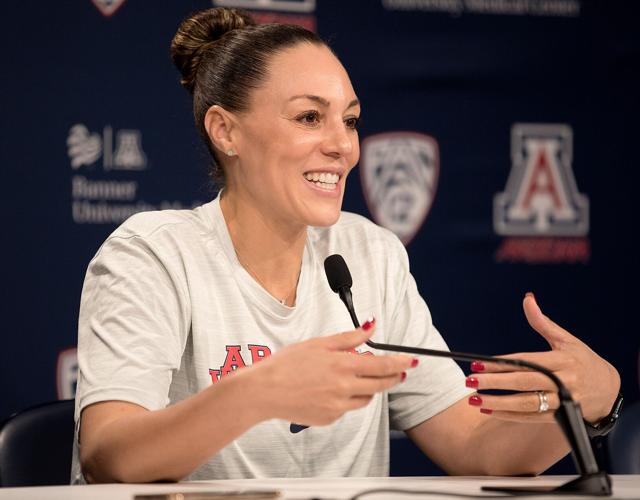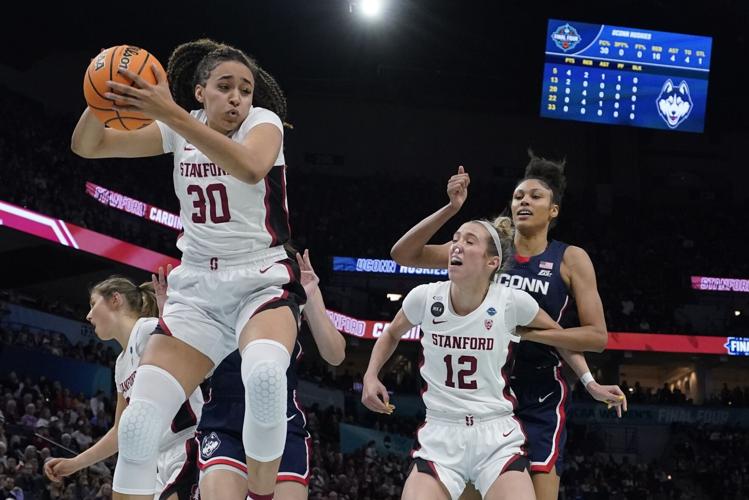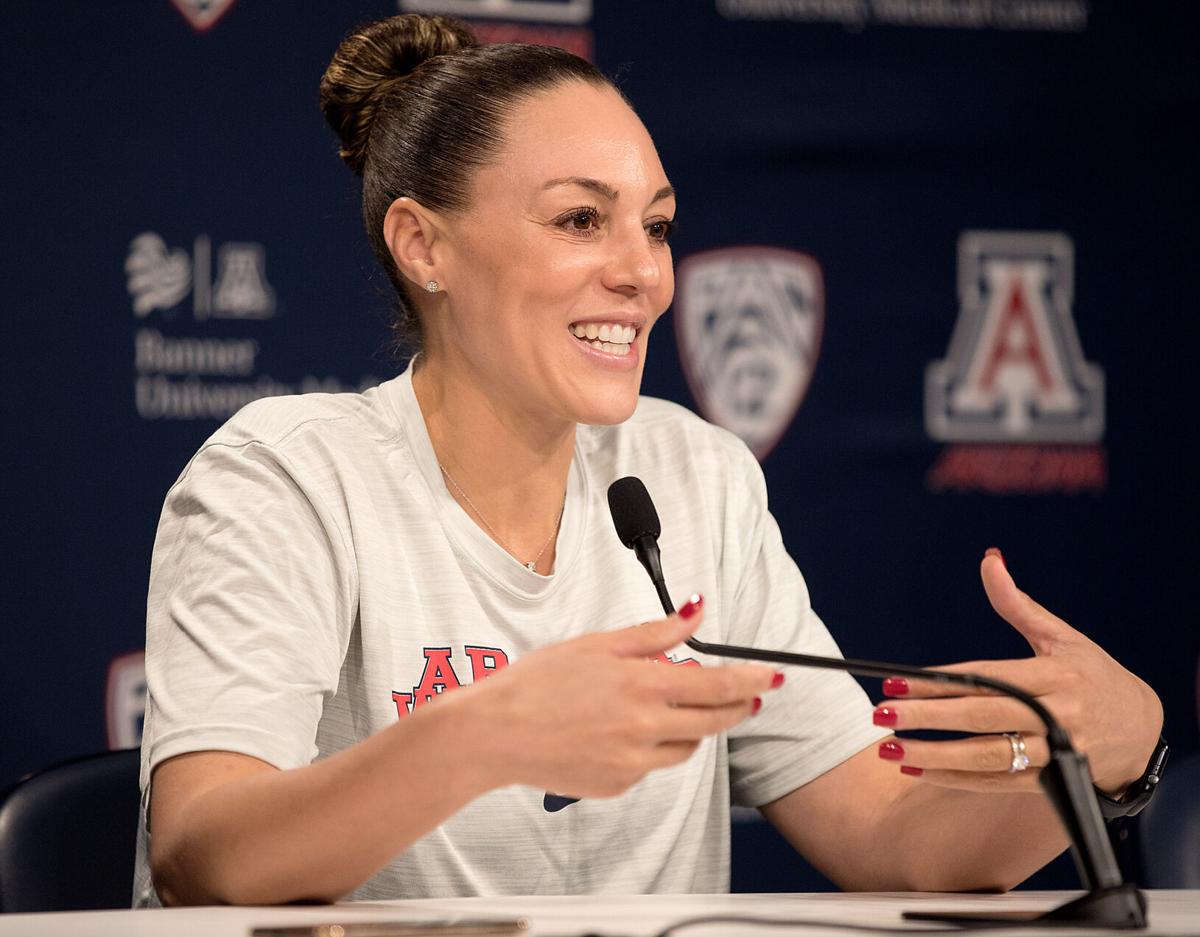SAN FRANCISCO — It’s no doubt a busy time for Pac-12 commissioner George Kliavkoff as he prepares for the conference’s next media rights deals to take shape.
But while the focus has primarily been on football and some on men’s basketball, there’s another college sport that Kliavkoff says is a key point in the preliminary discussions.
“As we’re talking to all of the potential distributors, they want to talk about women’s basketball,” Kliavkoff said on Tuesday at the Pac-12 women’s basketball media day.
And Kliavkoff wants to talk about that sport, too. It’s not just because the Pac-12 is one of the best conferences in the country in women’s basketball, with the 2021 national champion in Stanford and seven Final Four appearances from five different schools — three by Stanford (2017, 2021 and 2022) and one each by Arizona (2021 runner-up), Oregon (2020), Oregon State and Washington (both in 2016).
It’s because women’s basketball is about to become a revenue sport, too.
“I think women’s basketball is our fastest-growing television sport,” Kliavkoff said. “Ratings are increasing faster than any other sport. And I think it’s one of the sports that has been undervalued traditionally, in media rights. I think that provides a great opportunity.”
That undervaluation is true across the board for potential television distributors. The 2021 gender equity review showed that the NCAA’s package deal with ESPN that included the championships of all of the sports outside of men’s basketball and FBS football — $34 million per year for all 29 championship competitions — drastically undervalued several sports, especially women’s basketball.
In the report, it’s estimated that women’s basketball alone could garner “between $81 and $112 million annually, beginning in 2025.”
While that doesn’t compete with the $1.1 billion the NCAA receives annually from Turner for its men’s tournament or the $470 million ESPN pays for the CFP, the report estimates that the NCAA is leaving tens of millions on the table each year, and that figure is likely to keep growing.
Looking at the ratings can show why. Last season’s national championship game between South Carolina and UConn drew 4.85 million viewers on ESPN, making it the most-viewed title game since 2004. Stanford’s semifinal loss to UConn had 3.23 million viewers, the most-watched semifinal in a decade.
And it’s not just in the win-or-go-home postseason that women’s college hoops are putting up huge numbers. Last season saw the first regular season women’s college basketball game broadcast on ABC, when UCLA met UConn in New Jersey on Dec. 12. The matchup averaged 839,000 viewers for the game, which didn’t include UConn star Paige Bueckers.
Last season’s regular-season showdown between Stanford and South Carolina had 314,000 viewers, even with the Tuesday, Dec. 21 game broadcast on ESPN2 at 5 p.m.
This season’s game, between the last two national championships, will air on ABC, like last season’s UCLA-UConn game. Could this year’s matchup between the potential top two WNBA Draft picks in 2023, South Carolina’s Aliyah Boston and Stanford’s Haley Jones, cross the 1 million viewer mark? It sure seems possible.
“I’m thrilled that players like Haley, Cam (Brink) have a chance to play on ABC,” Stanford head coach Tara VanDerveer said. “We love playing on the Pac-12 Network and ESPN, but ABC will just get you into more homes. We want the young girls, boys, old men, women, whoever to see these great players and the great teams. It is absolutely thrilling.”
It’ll be the first of two games shown on ABC this year, with Stanford’s home game against Tennessee on Dec. 18 being the other. On other ESPN networks, though, the conference will only have three games during the regular season as well as the conference championship game and won’t have any on Fox networks, the conference’s other broadcast partner.
Meanwhile, the men’s side will have 45 total games on the ESPN family of networks (including three Pac-12 tournament games, one of which is the title game) plus a game on ABC, 22 on Fox networks and even 3 conference broadcasts on CBS.
The disparities between the men’s and women’s basketball broadcast slates are carried over from the original television rights deal that has two seasons remaining. But given the trends across women’s basketball, it will surely look different on the next deal.
And while so much of the external discussion about the new media rights deal center around football and men’s basketball, make no mistake: The women’s basketball rights are a significant financial factor, too.

Last year’s Final Four game between Stanford and UConn drew 3.23 million viewers, making it the most-watched semifinal game in a decade.
It’s part of a trend that crosses over every level of women’s basketball. At the professional level, the WNBA saw a 22% increase in viewership for games on ESPN during the entire 2022 season, with an average of 412,000 viewers across the 49 games on ESPN. The postseason saw a similar 22% jump, with an average of 456,000 viewers.
And at the end of September, ESPN televised the FIBA World Cup from Australia, with most games on ESPN+ but six games on television, including the championship game between Team USA and China that tipped off at 11 p.m. PT on ESPN. Even at that hour, the broadcast averaged 446,000 viewers for the game.
It’s a growth that’s not lost on some Pac-12 coaches.
“Our game is growing. It does matter,” Arizona coach Adia Barnes said. “You should invest in women’s basketball. It can make you money. And I think that’s important.”
VanDerveer agreed, adding that the Pac-12 Networks — much maligned in the football space — have been a major positive for women’s basketball.
“Pac-12 Networks has put Pac-12 women’s basketball on the map,” VanDerveer said. “We always were good, but now people know about it.”
The television distributors know it, too, and they’ll soon get a chance to put their money where the ratings are with women’s basketball. The NCAA’s deal with ESPN for all of its national championships aside from football and men’s basketball expires after 2024, with the expectation that women’s basketball will now be negotiated separately, too.
On the professional level, the WNBA reportedly brings in between $25-35 million a season for its TV rights in a deal that expires after the 2025 season. With ratings that are similar to or better than Major League Soccer — which just signed a deal with Apple TV to have all of its games exclusive on the streaming platform for $250 million per season — there’s a chance that the WNBA could increase its own yearly TV rights revenue tenfold.
With streaming services getting involved, that seems like a space where the Pac-12 is ready to capitalize. Amazon is performing well with its Thursday Night NFL game and Apple TV is making pushes for MLB and MLS games, so the long-fabled streaming service option appears to be materializing just at the right time for the Pac-12.
And women’s basketball is a sizable part of that, even with USC and UCLA leaving for the Big Ten.
“We’ve been the best conference in the country for the last half-decade, and I don’t think that’s going to change, quite frankly,” Oregon head coach Kelly Graves said. “I wouldn’t say there’s pressure, but I think it is important that we put our best foot forward, that we do have another outstanding season as a conference.”
While the coaches and teams are hoping to keep that success going on the floor, the off-the-court success will ultimately land on Kliavkoff. The commissioner who has only been in charge for 18 months initially raised eyebrows for the wrong reasons in the women’s basketball world by answering a question about the sport with: “We know where our bread is buttered. We’re focused on the revenue sports and winning in football and men’s basketball.”
But now? It’s clear that, to television distributors, women’s basketball is one of the sports that is going to butter the conference’s bread.
“They want to talk about how to highlight our women’s basketball programs,” Kliavkoff said. “They understand the quality of our programs, and they understand more importantly, the ratings that it will draw for them.
“It’s a huge part of what’s going to drive our immediate value which I think we’re going to be very proud of when we’re done with our deals.”
Or, as Barnes put it: “They better take advantage of it, because we’re getting big-time.”






